Ibogaine
(Iboga, 10-Methoxyibogamine)
TrippyWiki score: 7.2/10
TABLE OF CONTENTS

What is ibogaine?
Ibogaine is an alkaloid that comes from an African plant called iboga. Ibogaine isn’t as safe as most other psychedelics but it is the most effective substance we know of when it comes to treating addictions, especially opioid addiction.
Why choose ibogaine over other psychedelics?
Ibogaine…
Long-term benefits & side effects
Many of the benefits will only occur if you follow the tips below.
Most (if not all) of the side effects are preventable and they will not happen if you follow the Safety checklist.
Ibogaine…
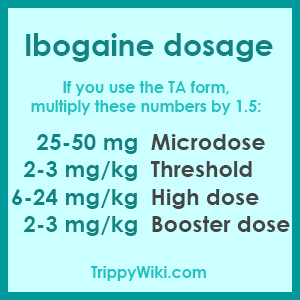
How to take ibogaine
Administration
Ibogaine is taken orally. You can either use Ibogaine HCl, a TA form, or a root bark form (usually sold in capsules). Iboga root bark can have anywhere from 2-4% of ibogaine in it and 1-7% of alkaloids.
Dosage
The doses below are displayed for Ibogaine HCl. If you use the TA version, multiply the dosages by 1.5.
For microdosing, doses of 25-50 mg are being used.
In ibogaine psychotherapy, patients first receive a threshold dose of 2-3 mg/kg of body weight at least 2 hours before taking the full dose to test for possible allergy to the substance.
A high dose used in psychotherapy sessions is anywhere from 6-24 mg/kg. Opioid addicts should usually take at least 15 mg/kg.
For personal development, doses of 8-12 mg/kg seem optimal.
Doses over 12 mg/kg might cause heart problems to people who are predisposed to them.
There is a report of a woman who took 8 mg/kg and died 4 hours later. Later, it was found that she had a familial history of heart problems.
Never exceed 24 mg/kg in a 24-hour period, it could be dangerous even if you are a healthy individual.
Booster doses of 1-5 mg/kg are given to psychotherapy patients a few times in the following weeks or months after the high dose if they notice any opioid withdrawal symptoms.
Safety checklist
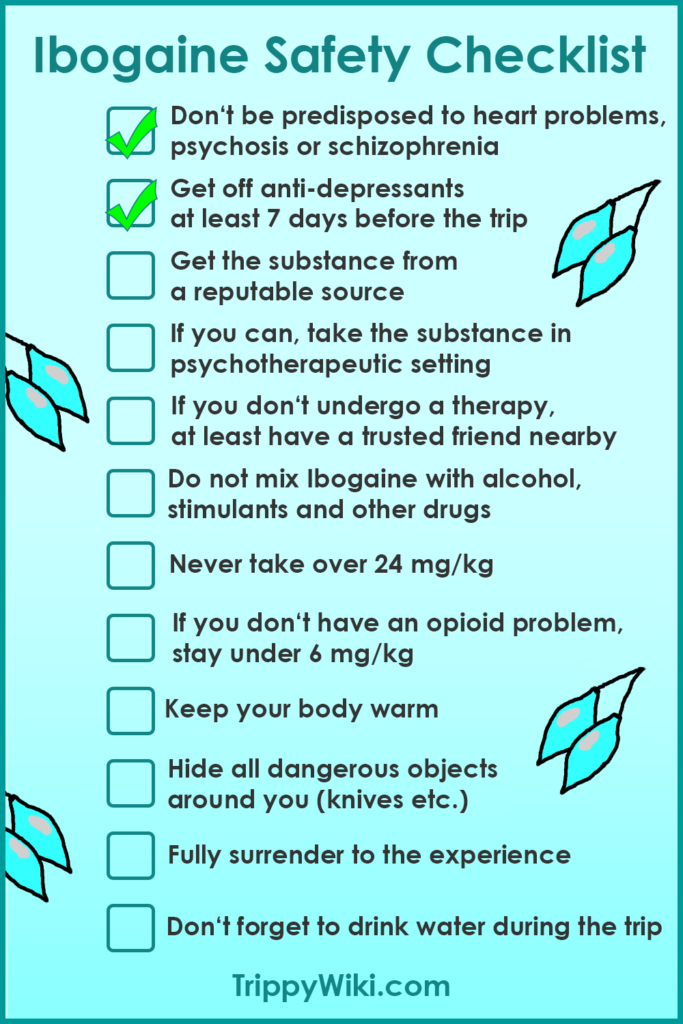
Maximize the benefits
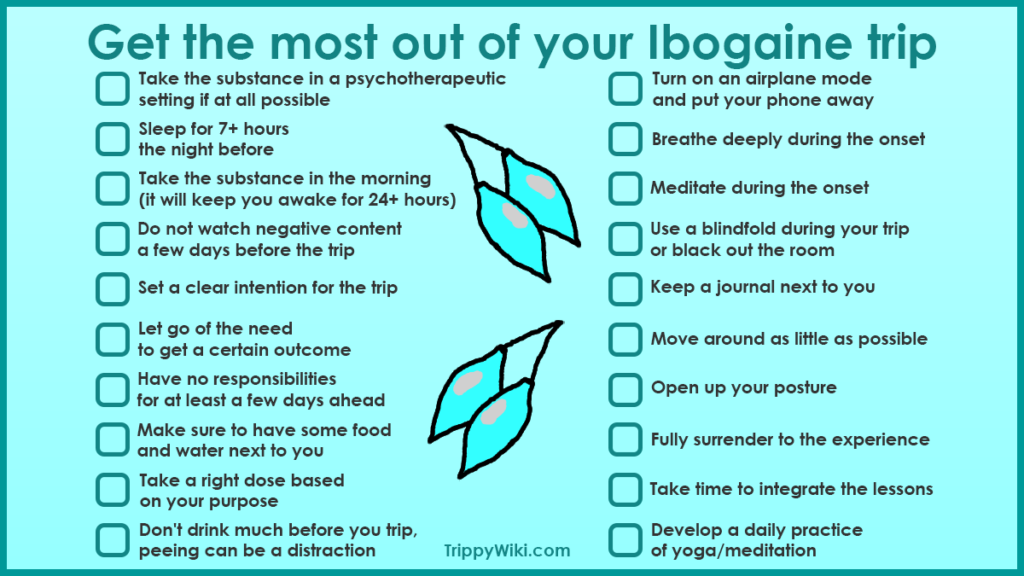
Keep in mind that integration might be even more important than the trip itself. Taking ibogaine would be useless if you didn’t retain any lessons in your day-to-day life.
What will help you the most is contemplating about the experience – be it by journaling, thinking about the trip, or sharing your memories with a trusted friend.
Distracting thoughts can get in the way, which is why you want to spend the day after your trip without TV, social media, and other distractions.
If you can, spend time in silence and solitude. Meditate, go for a walk, contemplate the experience.
Duration
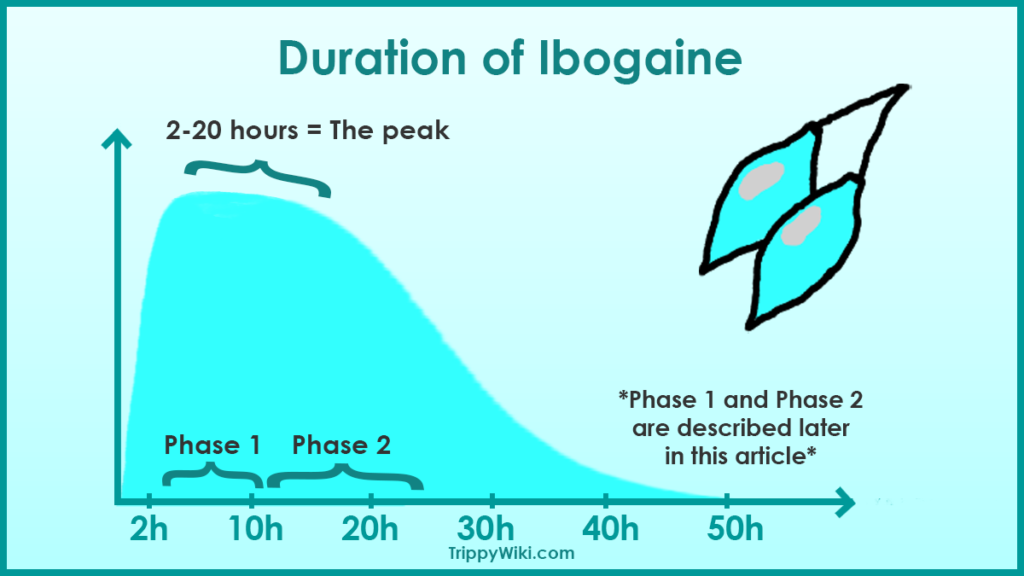
Onset = 45-180 minutes
Peak = 18-24 hours
Comedown = 8-12 hours
After effects = 24-70 hours
What ibogaine feels like
A high-dose ibogaine experience can be divided into 3 phases:
Phase 1
During this phase, most people visualize re-living their life. The visualizations may be intense but during this phase, users stay detached and don’t get too emotional. The hallucinations are similar to dreaming and people often feel like they are floating.
Phase 2
During this phase, users get to evaluate their life and the memories they have from phase 1. This is the most difficult part of the trip. Users are likely to experience sadness, anger, and regret.
Phase 3
This phase still involves introspection to some extent. Users are likely to experience stimulation and insomnia.
Other common short-term effects include:
High energy
Euphoria
Greater sexual desire
Less hunger
Increased creativity and open-mindedness
Seeing life from a different perspective
Appreciating small things
Increased awareness
Stamina enhancement
Time distortion
Mild open-eyed visual effects
Confusion
Dry mouth
Nausea, vomiting
Increased body temperature
Increased heart rate
Worse thermoregulation, coldness
Anxiety, paranoia
Vulnerability
The higher dose you take, the more intense these effects will be.
With that said, the only way to truly know what ibogaine feels like is to try ibogaine.
Bad trips on ibogaine
When you take a high dose of ibogaine, you will inevitably face some bad emotions.
There is nothing wrong with that and facing your shadow can be the most healing and transformative experience of your life.
With that said, there are some things you want to avoid if you don’t want the drug to make you traumatized:
How to cope with a bad trip
How to end a bad trip
In case you are not ready to face your inner demons yet, there are a few ways to end a bad trip.
One possible way is to put on music that is familiar to you. Another way is to switch up your location and move from one place to another. This can completely change your train of thought.
In case the trip becomes extremely challenging and there is no one around you to keep you safe, consider ending your trip with a trip killer.
Using a trip killer usually is not the best idea because the bad emotions will stay unresolved and you will get little to no benefits from the experience. With that said, using a trip killer is smarter than harming yourself.
The 2 best options that you have for ending a bad trip are Phenibut and benzodiazepines.
Phenibut is generally safer. The downside is that it can take hours to kick in.
So to end a trip, use benzodiazepines but only do this if you completely have to.
Interactions
Microdosing
Ibogaine is perhaps the best substance to microdose with.
In the past, African tribes used to take tiny doses of iboga root to lower their hunger, thirst, and to stay awake.
Today, people take microdoses for multiple reasons: to enhance mood, treat addictions, have higher energy, enhance cognition and physical activity, and a lot more. Some people also use ibogaine as an aphrodisiac.
A recommended microdose is 25-50 mg but lower doses may be sufficient. The optimal dose to take is highly individual.
Microdoses of ibogaine are taken daily but you want to cycle on and off. If you don’t do it, you are likely going to experience insomnia.
Microdosing is generally safe and you can stop at any time in case you notice some adverse reaction or if you simply don’t see any benefits.
If you are going to microdose with ibogaine, make sure to start small and build your way up.
If microdosing makes you jittery, you are probably taking too much.
History of ibogaine
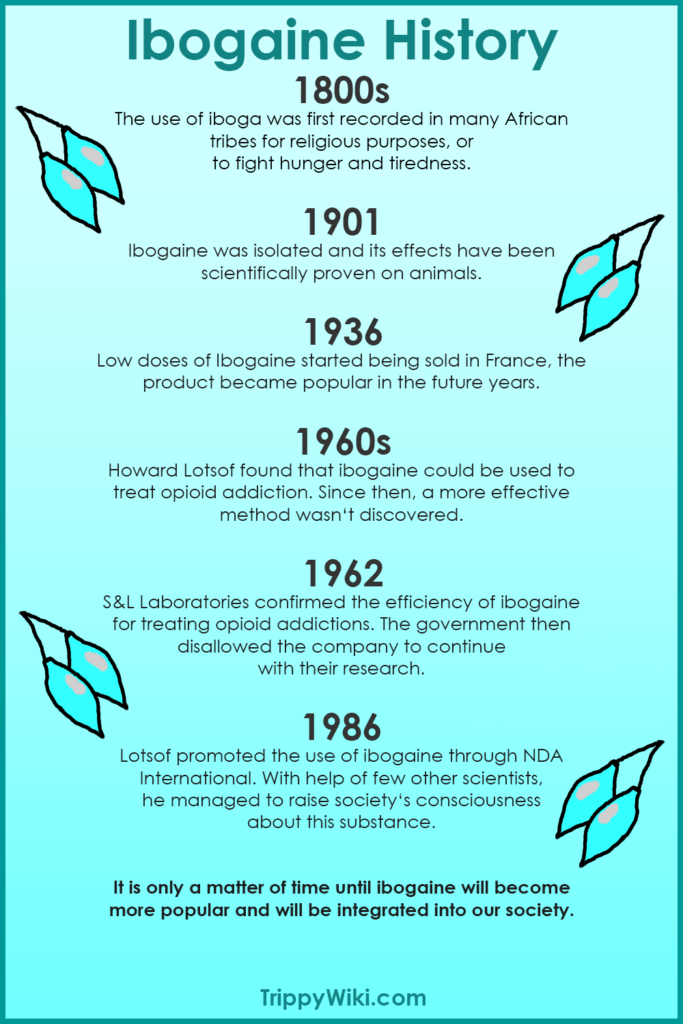
Legality
As of 2021, ibogaine is controlled in the US, Italy, Australia, Denmark, Sweden, and a few other countries.
Elsewhere, you can legally get your hands on ibogaine. These countries include Mexico and Canada.
Where to get ibogaine
These are the ways you can get your hands on the psychedelic, ranked from the safest to the least safe:
FAQ
You may also like:
Thank you for taking psychedelics responsibly, immature psychonauts are the last thing the psychedelic movement needs.
And thank you for being a part of this renaissance. Together, we can change the world!
